One of the questions that our research project Spaces of Justice across the East-West Divide seeks to tackle is: How can we imagine and analyze spaces of justice across the Finnish-Russian border without falling into the trap of methodological nationalism? In this blog post, we reflect on the promise of the collage methodology in cultivating “queer intellectual curiosity” (Weber 2016b), which disturbs the coherence of sovereign states and international orders, and therefore enables the foregrounding of relational spaces of justice. We report our experiences of organizing experimental workshops where university students produced collages alongside academic lectures, discussions and readings regarding politics of gender and sexuality and politics of space
It is common to analyze the politics of gender and sexuality through national framings. In these discussions, similarities within nationally defined groups are emphasized and differences are identified across state borders. Space is thought about in absolute terms.
By contrast, relational space is a product of dynamics and interrelations that run through spatial scales and borders; it is a sphere of possibility and multiplicity, and a space that is never closed or fixed (Massey 2005). Arguably, such a relational view of space resonates with key ideas of Queer IR, i.e. efforts to problematize the in/exclusions and boundaries of nations that the international order is based upon (Peterson 2014).
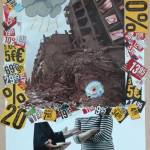
In order to discuss the spaces of gender and sexuality in a relational manner, our research project seeks to develop a collage epistemology, methodology and pedagogy. More specifically, we propose that collaging enables the discussion of the politics of gender and sexuality — and its spaces — to be queered.
Collaging and queering seem to make suitable epistemological partners: queering is about deconstructing categories of thought and practice while collages, as a form of inquiry, have multivocal and nonlinear representational potential.
The epistemological potential of collages
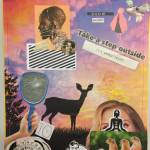 The term collaging has its roots in the French word coller, which means sticking or gluing together (e.g. Butler-Kisber 2008). Collage-like compositions have a long history in folk art, and often use diverse materials such as postage stamps, bones, plants, and other materials. Within the art world, Pablo Picasso, George Braque, Juan Gris and other cubists are often identified as the “founders” of collaging. Their conceptualization of collaging quite easily brings to mind queering: Collages offer a way to represent the intersection of multiple discourses and to disrupt the purity of the painted surface of conventional art — in other words: art is queered (Brockelman 2001:2; Banash 2004).
The term collaging has its roots in the French word coller, which means sticking or gluing together (e.g. Butler-Kisber 2008). Collage-like compositions have a long history in folk art, and often use diverse materials such as postage stamps, bones, plants, and other materials. Within the art world, Pablo Picasso, George Braque, Juan Gris and other cubists are often identified as the “founders” of collaging. Their conceptualization of collaging quite easily brings to mind queering: Collages offer a way to represent the intersection of multiple discourses and to disrupt the purity of the painted surface of conventional art — in other words: art is queered (Brockelman 2001:2; Banash 2004).
Today, the interest surrounding the epistemological potential of collages appears to be increasing amongst social scientists. Collages are appreciated for their ability to problematize assumptions of linearity, which forms of textual expression often (re)produce. Therefore, collages can express the idea of relationality in powerful ways. As Robertson argues:
[C]ollage reflects the very way we see the world with objects being given meaning not from something within themselves, but rather through the way we perceive they stand in relationship to one another (Robertson cit. Norris et. al. 2007, 483).
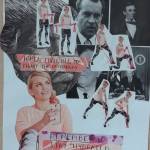
Given the way in which language is structured, it tends to maintain norms and normalize meaning-making through a certain set of differences, through the logic of either/or. As collaging combines a variety of materials and modes of expression, its epistemological points of departure resonate with queering. Both are about recognizing the limits of language and becoming aware of the binaries that language reproduces. In this sense, collaging can also be understood as working with gaps, overlaps, holes, absences and silences — or lapses and excesses of meaning — that queering aims to bring to the fore (Sedgwick 1990).
We are not the first to point out the commonalities between queering and collaging or related methods. Jasbir Puar, for example, argues that the act of assembling different materials and queerness both “challenge a linear mode of conduction and transmission” (Puar 2007:xv; cf. Weber’s (2016b) discussion of Haraway’s notion of figuration). Just as collaging seeks to represent the intersection of multiple discourses, queering attempts to complicate the assumption of stable borders and coherent sovereign wholes. The stability of borders disappears, and they begin to look like perpetually unsettled arrangements.
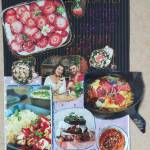
Vänskä (2011), inspired by Sedgwick, also associates queering with looking at the “ordinary” from another angle, viewing it as something strange. Queering involves asking what is made visible and what remains invisible.
Thus, both queering and collaging are attempts to foreground relationalities: seeing surprising connections between things and issues as well as dismantling and challenging the power relations that guide us to see things in specific ways.
Queering and collaging borders
According to Wickman (2016), the ‘queer perspective’ has three components: queer theory, radical activism and gender or gay/lesbian studies (Wickman 2016). As a social scientific notion, the term queer is not another signifier of sexual difference; it is a broader notion than a synonym for non-heterosexuals. “‘Queer’”, as Lauren Wilcox (2016) argues, “is not an object to be studied as in a ‘queer’ or ‘sexuality’ variable.”
Queering is not limited to theorizing sexual identifications. It is a way of thinking and doing that resists ‘proper objects’ and avoids exclusionary moves that signify monolithically. It is “unsettleable, intersectional, uncaging, multiple (and multiplied), both/and, … engaged in projects of (the productivity of) failure and maybe even destruction” (Sjoberg 2014, 608 in reference to Weber (1999), Edelman (2004) and Halberstam (2011)).
As our research project is by definition ‘Finnish-Russian’, we have drawn inspiration from Queer IR for our discussion of spaces of justice. International Relations’ queer theorists have shown that the ‘proper objects of IR’ — the fundamental IR institutions such as the state or borders — are based on assumptions of heterosexual, reproductive sex (Wilcox 2014; Weber 2016).
Peterson (2014) shows that the in/exclusions through which nations are bounded depend on a set of heteronormative family/kinship rules.Thus, queering the intimate also queers the international (ibid). It messes up the static surface of the Westphalian map, which attempts to make it clear where one state and society ends and another one begins.
In our project, which is about imagining and creating spaces of justice across the east-west divide, we have also found use in Sjoberg’s argument that queering is about “recognizing the layers of ‘drag’ in borders” (Sjoberg 2014:610).
Collaging provides one possibility to acknowledge the existence of layers of drag in the spatial imaginaries that IR and other social sciences often operate with. It is a form of inquiry that can make visible spaces of justice across various power political dividing lines, spaces that are relational, multiscalar and non-fixed.
Experimenting with a collage pedagogy
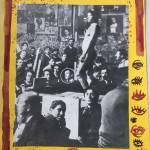 The basic idea of collages is that found objects, such as ready-made texts, images or other objects are taken and reassembled into compositions. This is why collages are not only a democratic art form but also suitable for pedagogic purposes: It is possible to produce collages using low-tech utilities – glue, scissors, paper, found objects, images. Furthermore, collaging does not require specific artistic training or refined artistic skills. Collages are meant to be undisciplined, in a word, queer. For these reasons, offering collaging sessions is also relatively easy in different university settings.
The basic idea of collages is that found objects, such as ready-made texts, images or other objects are taken and reassembled into compositions. This is why collages are not only a democratic art form but also suitable for pedagogic purposes: It is possible to produce collages using low-tech utilities – glue, scissors, paper, found objects, images. Furthermore, collaging does not require specific artistic training or refined artistic skills. Collages are meant to be undisciplined, in a word, queer. For these reasons, offering collaging sessions is also relatively easy in different university settings.
Our attempt to develop a collage methodology and pedagogy has involved organizing various experimental workshops where university students produced collages alongside academic lectures, discussions and readings regarding politics of gender and sexuality and politics of space.
For the workshops, we have either given students a pre-assignment where they have been asked to collect different types of materials for collages on a certain topic or theme. In other workshops, we just brought along stacks of magazines, old books, paper, scissors, glue, various objects, colored pencils and crayons. Each collaging sessions lasted for approximately two to three hours, during which we have also been able to have interesting discussions about the workshop themes, class readings and lectures that have been part of the workshop programme.
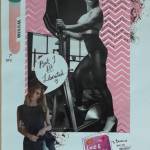
One of the pedagogical benefits of collaging together is that having a discussion while simultaneously crafting something levels the playing field between introverted and extroverted students, and between the teachers and the students. It may also be meaningful for students with special needs, such as dyslexia. When the focus is on the materials rather than the speaking subject, there is also less pressure to perform seriousness and as a result the students are not afraid to speak their minds. This also enables difficult theories and topics to be processed in a more practical manner.
Have we been able to queer spaces of justice in our collage workshops?
Some of the collages that the workshop participants have produced are explicitly about problematizing container imaginaries. Whereas, some are about destroying assumptions of ‘inside’ and ‘outside’. In many of the collages, the layeredness of materials expresses the complexity of gender and sexual identifications. But some of the collages also reproduce the idea of a nation-state as the framework within which political of gender and sexuality are be examined. As one of the workshop participants wrote,
Now that I reflect back on the artwork that I made I realize, that it reflects methodological nationalism, even though I did try my best to avoid it. For example in my collage, I critiqued the narrow role reserved for Finnish women and the heteronormative assumptions – as well as the assumption of whiteness. But I did not for a minute problematize the fact that by doing that I actually took an imaginary “nation” as the subject of my collage.
The student’s reflection calls to mind Eve Sedgwick’s (2003) concept of reparative reading. In this instance, queering can be understood as repairing knowledge, in order to show what knowledge lacks. Therefore, collage pedagogy — which also involves shared reflection on the collages — can be seen as a gesture toward positive non-normative, non-dualistic, and non-linear reparative acts on knowledge. It is a methodology and pedagogy which enables the limits of knowledge to be made visible. Thus, it also challenges the sturdiness and durabilty of national framings we social scientists are so used to leaning on.
Written by Anni Kangas, Inna Perheentupa and Saara Särmä
Sources
Banash, D. (2013) Collage Culture: Readymades, Meaning, and the Age of Consumption. Amsterdam: Rodopi.
Brockelman, T. P. (2001) The Frame and the Mirror: On Collage and the Postmodern. Evanston: Northwestern University Press.
Butler-Kisber, L. (2008) “Collage as inquiry.” In J. G. Knowles & A. L. Cole, eds. Handbook of the arts in qualitative research: Thousand Oaks: Sage, pp. 265–276.
Edelman, L. (2004) No Future: Queer Theory and the Death Drive. Durham: Duke University Press.
Halbertstam, J. (2011) Queer Art of Failure. Durham: Duke University Press.
Massey, D. (2005) For Space. London: Sage.
Norris, G., Mbokazi, T., Rorke F., Goba S. & Mitchell C. (2007) “Where do we start? Using collage to explore very young adolescents’ knowledge about HIV and AIDS in four senior primary classrooms in KwaZulu‐Natal”, International Journal of Inclusive Education 11:4, 481-499.
Peterson, S.P. (2014) “Family Matters: How Queering the Intimate Queers the International”, International Studies Review 16(4), 604–608.
Puar, J. (2007) Terrorist Assemblages. Durham: Duke University Press.
Sedgwick, E. 1990. Epistemology of the Closet. Berkeley: University of California Press.
Sedgwick, E. (2003) Touching feeling. Affect, Pedagogy, Performativity. Durham & London: Duke University Press.
Sjoberg, L. (2014) “Queering the “Territorial Peace”? Queer Theory Conversing With Mainstream International Relations”, International Studies Review 16:4, 608–612.
Vänskä, A. (2011) “Queer + pedagogia = mahdoton yhtälö?” Kasvatus 42:5, 455–467.
Weber, C. (1999) Faking It: U.S. Hegemony in a “Post-Phallic” Era. Minneapolis: University of Minnesota Press.
Weber, C. (2016a) Queer International Relations Sovereignty, Sexuality and the Will to Knowledge. Oxford: Oxford University Press.
Weber, C. (2016b) “Queer intellectual curiosity as international relations method: developing queer international relations theoretical and methodological frameworks.” International Studies Quarterly 60(1), 11–23.
Wickman, J. (2010) “Queer Activism: What Might That Be?” Trikster. Nordic Queer Journal 4.
Wilcox, L. (2014) “Queer Theory and the ‘Proper Objects’ of International Relations”, International Studies Review 16:4, 612–615.
Wilcox, L. (2016) “IR’s Queer Presence and Queer Potentials”, ISQ Online, http://www.isanet.org/Publications/ISQ/Posts/ID/5283/IRs-Queer-Presence-and-Queer-Potentials.

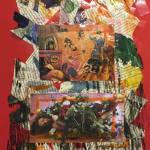
Comments